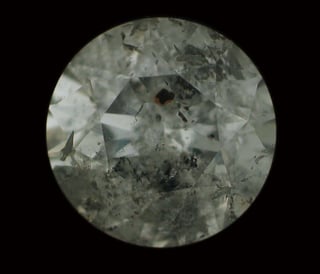
As a measure of value, diamond clarity plays a similar role to that of carat weight, in that flawless diamonds are so rare, they tend to be very expensive. However, most consumers are usually surprised by how little difference there is to a diamond’s appearance between two different clarity grades.
Many customers will be happy with a diamond that has no visible imperfections to the naked eye, while others are willing to pay more for a higher quality diamond that is closer to flawless. It is of great importance to educate your customers about clarity and explain the impact it has on a diamond’s brilliance. From this you can determine how important a diamond’s perfection is to your customer and then guide them towards a diamond most suited to their needs and desires.
What is Diamond Clarity?
Clarity refers to the number and size of tiny imperfections within a diamond. Most diamonds contain imperfections that form during their creation deep in the earth, in a region of extreme heat and pressure. According to the GIA, no completely flawless diamond exists, although some come close but are so rare that many jewelers will never see one.
Types of Imperfections
There are two major categories of imperfections in a diamond: inclusions, which are flaws internal to the diamond, and blemishes, which are found on the surface of a diamond.
Inclusions come in many forms, such as the small crystals which become trapped inside the diamond during its formation. Among other types of inclusions, there is graining, which occurs from an irregular atomic structure and feathers, which are internal breaks.
Unlike inclusions, blemishes occur after a diamond’s formation, either during the manufacturing process or from the wearing of a polished diamond set in jewelry.

Example of an I3 diamond.
The Grading Scale
The GIA Clarity Scale contains 11 grades:
• Flawless (FL)
• Internally flawless (IF)
• Two categories of very, very slightly included (VVS1 & VVS2)
• Two categories of very slightly included (VS1 & VS2)
• Two categories of slightly included (SI1 & S12)
• Three categories of included (I1, I2, I3)
In determining a diamond’s grade, the GIA considers the number, size, color, reflectivity, and position of every flaw visible under 10x magnification.
Together with the grade, the GIA also provides a diamond “plot” to map a diamond's interior and exterior flaws. This is a graphic representation of the flaws that contribute to the overall clarity grade. The top half of the diamond is represented by the diagram pictured on the left and the lower half of the diamond is represented by the diagram pictured on the right.
Explaining Inclusions to Your Customers
It is important for customers to understand that GIA grading for clarity is based on examining the diamond using a 10x magnification. This means that even diamonds with SI (slightly included) or I (included) clarity grades, can look flawless to the naked eye, depending on the size of the imperfections, the size of the diamond, and where they are found on or in the diamond. It is helpful to show your customers two diamonds with different grades: one VVS (very very slightly included) and one SI or lower, and let them compare the two with and without a magnifying loupe.
Many customers may think that because clarity has a large impact on the price of a diamond, it also means that a higher clarity grade is more beautiful. This is an opportunity to explain to your customers that a lower grade diamond which is eye-clean (meaning no imperfections are visible to the naked eye), and has no flaws which will impact its structural integrity, can be just as beautiful as a higher grade diamond, but at a lower cost. Also, if your customer finds a diamond with a visible imperfection yet it meets most of their specifications, it could still be the right diamond for them. For example, if the imperfection is located near the edge, the prong could cover it when set, making the imperfection "invisible."

As a diamond retailer, it's often standard practice to draw your customer's attention to cut and color over a higher clarity grade, which can make almost no difference to the diamond's overall beauty and impact. Nevertheless, it is important to take the customer’s personal thoughts and opinions about higher clarity diamonds into consideration, so that he leaves feeling confident and delighted with his purchase.
Conclusion
From the outset it is important to determine how your customer feels about diamond clarity and quality. Take the time to educate them about the different clarity grades and how buying a more expensive, better quality diamond doesn’t necessarily mean the diamond is more suited to their needs. Many customers will appreciate the honesty of a diamond jewelry retailer not trying to sell them a more expensive diamond, which in fact will have little impact of their final piece of jewelry. However, if your customer feels strongly about diamond quality, even with this knowledge to hand, be sure to guide them towards the best diamond for their needs, desire and budget.


 RapNet Blog
RapNet Blog





